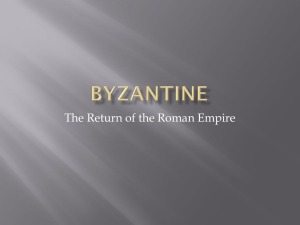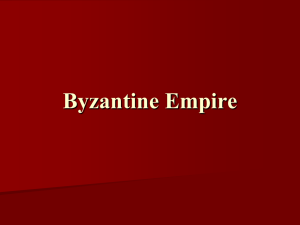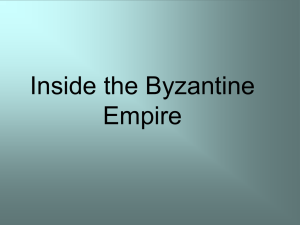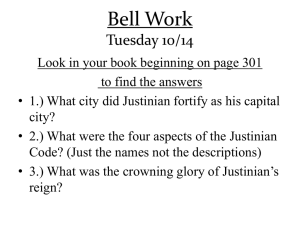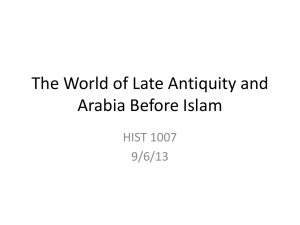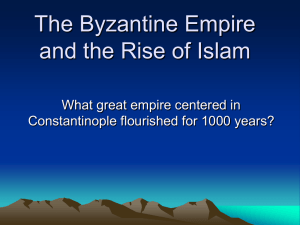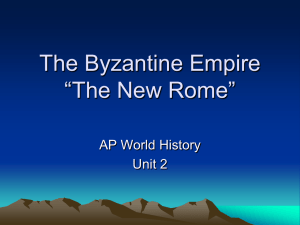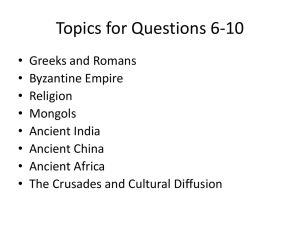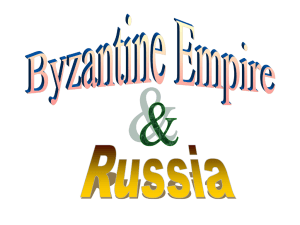After the Fall (Byzantine Empire)
advertisement
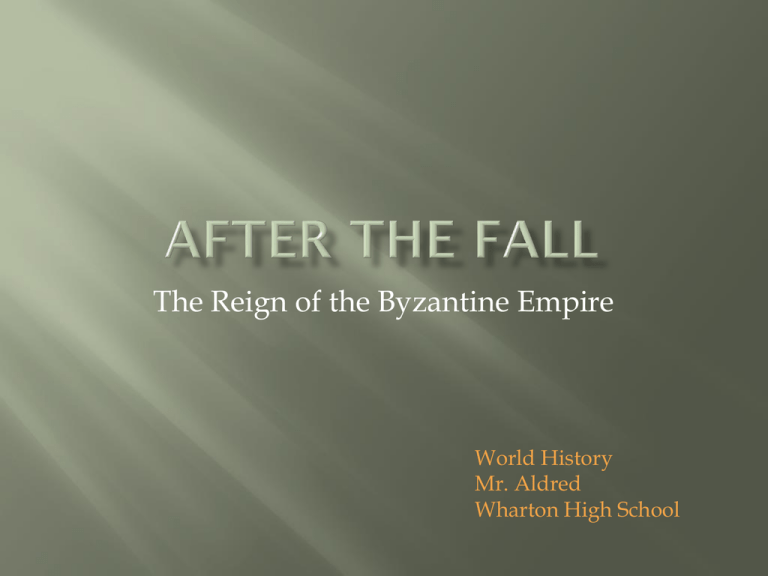
The Reign of the Byzantine Empire World History Mr. Aldred Wharton High School Internal problems and invasions spurred the division and decline of the Roman Empire In the third century A.D., Rome faced many problems They came both from within the empire and from outside. Only drastic economic, military, and political reforms, it seemed, could hold off collapse In the late 3d century CE, Emperor Diocletian believed that the empire had grown too large and too complex for one ruler In perhaps his most significant reform, he divided the empire into the Greekspeaking East (Greece, Anatolia, Syria, and Egypt) and the Latin-speaking West (Italy, Gaul, Britain, and Spain) Constantine gained control of the western part of the empire in A.D. 312 and continued many of the social and economic policies of Diocletian In 324 Constantine also secured control of the East, thus restoring the concept of a single ruler In A.D. 330, he moved the capital from Rome to the Greek city of Byzantium in what is now Turkey Western Roman Empire Rome Eastern Roman Byzantium Empire The division of the Roman Empire around 476 AD With Byzantium as its capital, the center of power in the empire shifted from Rome to the east The city eventually took a new name— Constantinople – the city of Constantine After Constantine’s death, the empire would again be divided The East would survive; the West would fall In 410 AD, the city of Rome itself falls to the marauding Visigoths under Alaric The eastern half of the empire, which came to be called the Byzantine Empire, not only survived but flourished It preserved the great heritage of Greek and Roman culture for another 1,000 years The Byzantine emperors ruled from Constantinople and saw themselves as heirs to the power of Augustus Caesar As the former western half of the Roman Empire was subject to continuous attack from various Germanic tribes, the eastern half of the empire weathered the storm Under Justinian, the emperor of the East begins to take back much of the territory lost to the barbarian tribes Play Video Clip A. B. Justinian The New Rome the Western Roman Empire crumbled in the fifth century as it was overrun by invading Germanic tribes like the Huns, Goths, and Vandals Still, rulers in the East continued to see themselves as emperors for all of Rome In 527, a high-ranking Byzantine nobleman named Justinian succeeded his uncle to the throne of the Eastern Empire A Byzantine mosaic depicting Justinian and his court of advisors In an effort to regain Rome’s fading glory, Justinian in 533 sent his best general, Belisarius to recover North Africa from the invading Germanic tribes Belisarius and his forces quickly succeeded After numerous campaigns, Justinian’s armies won nearly all of Italy and parts of Spain Justinian now ruled almost all the territory that Rome had ever ruled The Eastern Roman Empire before Justinian Territory added during the reign of Justinian Byzantine Empire A. B. C. D. E. F. Eastern Influence Justinian’s Code Creating the Imperial Capital The Hagia Sophia Preservers of Culture Life in Constantinople A separate government and difficult communications with the West gave the Byzantine Empire its own character, different from that of the Western Empire The citizens thought of themselves as sharing in the Roman tradition, but few spoke Latin anymore Most Byzantines spoke Greek Having unified the two empires, Justinian set up a panel of legal experts to regulate Byzantium’s increasingly complex society The panel created a single, uniform code known as the Justinian Code The Justinian Code decided legal questions that regulated whole areas of Byzantine life Marriage, slavery, property, inheritance, women’s rights, and criminal justice were just some of those areas While his scholars were creating the legal code, Justinian launched the most ambitious public building program ever seen in the Roman world Church building, however, was the emperor’s greatest passion Justinian viewed churches as the most visible sign of the close connection between church and state in his empire The crowning glory of his reign was Hagia Sophia which means “Holy Wisdom” in Greek When Justinian rebuilt Hagia Sophia, many visitors hailed it as the most splendid church in the Christian world As it appears today Beneath such excitement, a less obvious but vitally important activity took place: the preservation of Greco-Roman culture Byzantine families valued education— specifically classical learning Basic courses for Byzantine students focused on Greek and Latin grammar, and philosophy The classics of Greek and Roman literature served as textbooks. Students memorized Homer They learned geometry from Euclid, history from Herodotus, and medicine from Galen The modern world owes Byzantine scholars a huge debt for preserving many of the great works of Greece and Rome Constantinople was truly a city at the “crossroads of culture” Products from the most distant corners of Asia, Africa, and Europe passed through the merchants who lined the streets along the Mese Everywhere, food stands filled the air with the smell of their delicacies, while acrobats and street musicians performed Byzantine art reflected everyday life and devotion to Christianity Meanwhile, citizens could enjoy free entertainment at the Hippodrome, which offered wild chariot races and performance acts The Hippodrome (from Greek words meaning “horse” and “racecourse”) held 60,000 spectators Fans of the different teams formed rowdy gangs named for the colors worn by their heroes The Hippodrome was part of a larger complex that included the Great Palace and Hagia Sophia In 532, two such fan groups sparked citywide riots called the Nika Rebellion (because the mob cried “Nika!” or “Victory!”) Both sides were angry with the government They packed the Hippodrome and demanded the overthrow of Justinian Belisarius, however, broke in with his troops and slaughtered about 30,000 rebels During the rebellion, Justinian was ready to flee the city to safety Theodora, his wife, urged him to stay As her husband’s steely adviser, Theodora had immense power She rallied Justinian to remain in the capital with a fiery speech “My opinion is that now is a poor time for flight, even though it bring safety. For any man who has seen the light of day will also die, but one who has been an emperor cannot endure to be a fugitive. If now you wish to go, Emperor, nothing prevents you. There is the sea, there are the steps to the boats. But take care that after you are safe, you do not find that you would gladly exchange that safety for death.” THEODORA, quoted by Procopius in History of the Wars Textbook, Page 303 A. B. C. Instability The Plague Attacks from the East and West After Justinian’s death in 565, the empire suffered countless setbacks There were street riots, religious quarrels, palace intrigues, and foreign dangers Each time the empire moved to the edge of collapse, it found some way to revive—only to face another crisis The first crisis actually began before Justinian’s death It was a disease that resembled what we now know as the bubonic plague This horrifying illness hit Constantinople in the later years of Justinian’s reign The plague probably arrived from India on ships infested with rats Historians estimate that in 542, the worst year of the plague, 10,000 people were dying every day The illness broke out repeatedly until around 700, when it finally faded By that time, it had destroyed a huge percentage of the Byzantine population Even Justinian himself was struck but remarkably he survived but it left him weakened and mentally unstable From the very start of its rise to power, Byzantium faced constant challenges from foreign enemies Lombards overran Justinian’s conquests in the west Avars, Slavs, and Bulgars made frequent raids on the northern borders The powerful Sassanid Persians attacked relentlessly in the east The Persians struck against Constantinople itself in 626 With the rise of Islam, Arab armies attacked the city in 674 and once again in 717 Slowly, the Byzantine Empire shrank under the impact of foreign attacks A. B. C. D. The Influence of Christianity A Religious Split The Iconoclasm Missionary Attempts During the Byzantine Empire, Christianity underwent a dramatic development Christianity had begun to develop differently in the Western and Eastern Roman Empires, due largely to the distance and lack of contact between the two regions As the Eastern Empire became Byzantium and flourished, those differences grew and ultimately split apart the Church Eastern Christianity built its heritage on the works of early Church fathers One was Saint Basil, who, around 357, wrote rules for the life of monks (see p. 304) As bishop of Constantinople from 398 to 404, Saint John Chrysostom was the patriarch or leading bishop of the East But even the patriarch bowed to the emperor A controversy that tested the emperor’s authority over religious matters broke out in the eighth century In 730, Emperor Leo III banned the use of icons, religious images used by Eastern Christians to aid their devotions The emperor viewed the use of icons as idol worship. People responded with riots, and the clergy rebelled In the West, the pope became involved in this eastern dispute and supported the use of icons One pope even ordered the excommunication of a Byzantine emperor—that is, he declared the emperor to be an outcast from the Church Differences between the Eastern and Western churches, continued to grow In 1054, matters came to a head when the pope and the patriarch excommunicated each other in a dispute over religious doctrine Shortly afterward, Christianity officially split between the Roman Catholic Church in the West and the Orthodox Church in the East As West and East grew apart, the two traditions of Christianity competed for converts Missionaries from the Orthodox Church, for example, took their form of Christianity to the Slavs, groups that inhabited the forests north of the Black Sea Slavs would be able to read the Bible in their own tongues Many Slavic languages, including Russian, are now written in what is called the Cyrillic alphabet Use the chart on page 305 to compare the differences between Roman Catholicism and Eastern Orthodox Christianity

